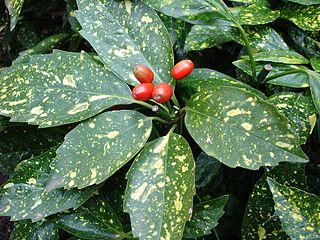
The Garryales are a small order of dicotyledons, including only two families and three genera.

Dandruff is a skin condition that mainly affects the scalp. Symptoms include flaking and sometimes mild itchiness. It can result in social or self-esteem problems. A more severe form of the condition, which includes inflammation of the skin, is known as seborrhoeic dermatitis.
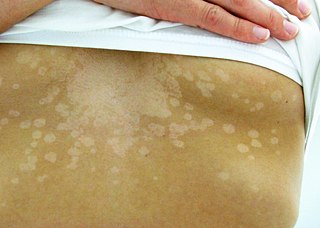
Tinea versicolor is a condition characterized by a skin eruption on the trunk and proximal extremities. The majority of tinea versicolor is caused by the fungus Malassezia globosa, although Malassezia furfur is responsible for a small number of cases. These yeasts are normally found on the human skin and become troublesome only under certain circumstances, such as a warm and humid environment, although the exact conditions that cause initiation of the disease process are poorly understood.

Cryptomeria is a monotypic genus of conifer in the cypress family Cupressaceae, formerly belonging to the family Taxodiaceae. It includes only one species, Cryptomeria japonica. It used to be considered by some to be endemic to Japan, where it is known as Sugi. The tree is called Japanese cedar or Japanese redwood in English. It has been extensively introduced and cultivated for wood production on the Azores.

Seborrhoeic dermatitis is a long-term skin disorder. Symptoms include flaky, scaly, greasy, and occasionally itchy and inflamed skin. Areas of the skin rich in oil-producing glands are often affected including the scalp, face, and chest. It can result in social or self-esteem problems. In babies, when the scalp is primarily involved, it is called cradle cap. Seborrhoeic dermatitis of the scalp may be described in lay terms as dandruff due to the dry, flaky character of the skin. However, as dandruff may refer to any dryness or scaling of the scalp, not all dandruff is seborrhoeic dermatitis. Seborrhoeic dermatitis is sometimes inaccurately referred to as seborrhoea.

Lonicera japonica, known as Japanese honeysuckle and golden-and-silver honeysuckle, is a species of honeysuckle native to eastern Asia, including many parts of China. It is often grown as an ornamental plant, but has become an invasive species in a number of countries. Japanese honeysuckle is used in traditional Chinese medicine.
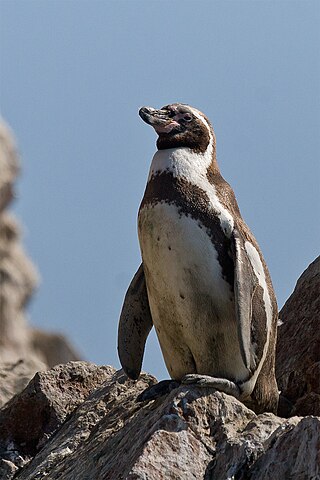
The Humboldt penguin is a medium-sized penguin. It resides in South America, its range mainly contains most of coastal Peru. Its nearest relatives are the African penguin, the Magellanic penguin and the Galápagos penguin. The Humboldt penguin and the cold water current it swims in both are named after the explorer Alexander von Humboldt. The species is listed as vulnerable by the IUCN with no population recovery plan in place. The current population is composed of 32,000 mature individuals and is going down. It is a migrant species.

Malassezia is a genus of fungi. It is the sole genus in family Malasseziaceae, which is the only family in order Malasseziales, itself the single member of class Malasseziomycetes. Malassezia species are naturally found on the skin surfaces of many animals, including humans. In occasional opportunistic infections, some species can cause hypopigmentation or hyperpigmentation on the trunk and other locations in humans. Allergy tests for these fungi are available. It is believed French revolutionary Jean-Paul Marat suffered from a fungal infection from Malassezia restricta, which lead to his frequent bathing in a medicinal substance.

Camellia japonica, known as common camellia, or Japanese camellia, is a species of Camellia, a flowering plant genus in the family Theaceae. There are thousands of cultivars of C. japonica in cultivation, with many colors and forms of flowers. Despite its common name, it is native to China, not Japan. The cultivation of Camellia japonica also started in China. Its widespread cultivation can be traced back to the Song Dynasty, when 15 varieties of Camellia japonica were recorded in literature. It was later introduced to Japan. It grows in forests, at altitudes of around 300–1,100 metres (980–3,600 ft).

Malassezia furfur is a species of yeast that is naturally found on the skin surfaces of humans and some other mammals. It is associated with a variety of dermatological conditions caused by fungal infections, notably seborrhoeic dermatitis and tinea versicolor. As an opportunistic pathogen, it has further been associated with dandruff, malassezia folliculitis, pityriasis versicolor (alba), and malassezia intertrigo, as well as catheter-related fungemia and pneumonia in patients receiving hematopoietic transplants. The fungus can also affect animals, including dogs.

Louis-Charles Malassez was a French anatomist and histologist born in Nevers, department of Nièvre.
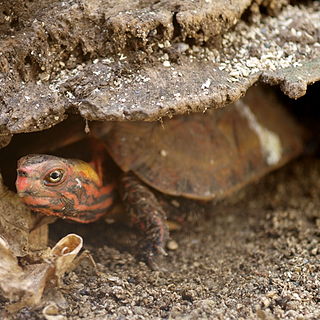
The Ryukyu black-breasted leaf turtle or Ryukyu leaf turtle is a species of turtles in the family Geoemydidae endemic to the Ryukyu Islands in Japan. In 1975, the species was designated a National Natural Monument of Japan. It grows to about 5–6 inches long. In captivity, it feeds on worms, snails, insects, and fruit. Due to its rarity and very attractive appearance, this species is highly coveted by turtle collectors worldwide.

The Japanese pond turtle, also called commonly the Japanese pond terrapin and the Japanese pond tortoise, is a species of turtle in the family Geoemydidae endemic to Japan. Its Japanese name is nihon ishigame, Japanese stone turtle. Its population has decreased somewhat due to habitat loss, but it is not yet considered a threatened species.

Malassezia globosa is a species of yeast-like fungus.
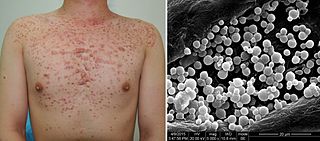
Malassezia folliculitis or Pityrosporum folliculitis, is a skin condition caused by infection by Malassezia yeast.

Teniloxazine, also known as sufoxazine and sulfoxazine, is a drug which is marketed in Japan. Though initially investigated as a neuroprotective and nootropic agent for the treatment of cerebrovascular insufficiency in the 1980s, it was ultimately developed and approved as an antidepressant instead. It acts as a potent norepinephrine reuptake inhibitor, with fair selectivity over the serotonin and dopamine transporters, and also behaves as an antagonist of the 5-HT2A receptor.
Malassezia pachydermatis is a zoophilic yeast in the division Basidiomycota. It was first isolated in 1925 by Fred Weidman, and it was named pachydermatis after the original sample taken from an Indian rhinoceros with severe exfoliative dermatitis. Within the genus Malassezia, M. pachydermatis is most closely related to the species M. furfur. A commensal fungus, it can be found within the microflora of healthy mammals such as humans, cats and dogs, However, it is capable of acting as an opportunistic pathogen under special circumstances and has been seen to cause skin and ear infections, most often occurring in canines.
Malassezia sympodialis is a species in the genus Malassezia. It is characterized by a pronounced lipophily, unilateral, percurrent or sympodial budding and an irregular, corrugated cell wall ultrastructure. It is one of the most common species found on the skin of healthy and diseased individuals. It is considered to be part of the skin's normal human microbiota and begins to colonize the skin of humans shortly after birth. Malassezia sympodialis, often has a symbiotic or commensal relationship with its host, but it can act as a pathogen causing a number of different skin diseases, such as atopic dermatitis.

NGC 4699 is an intermediate spiral galaxy located in the constellation Virgo. It is located at a distance of about 65 million light years from Earth, which, given its apparent dimensions, means that NGC 4699 is about 85,000 light years across. It was discovered by William Herschel in 1786. It is a member of the NGC 4699 Group of galaxies, which is a member of the Virgo II Groups, a series of galaxies and galaxy clusters strung out from the southern edge of the Virgo Supercluster.
Malassezia vespertilionis is a species of yeast-like fungus that grows on the skin of bats. It was described as a new species in 2018. The holotype was obtained from a swab of wing skin of a hibernating northern long-eared bat collected in Wisconsin. The species epithet vespertilionis uses the Latin vespertilio (bat) to refer to the host.
















